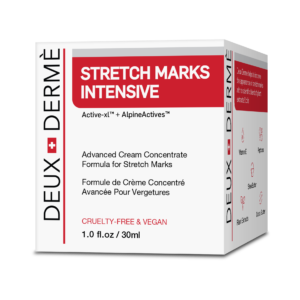Whether you’re currently suffering from stretch marks or are trying to prevent them, these answers to common questions will help you learn more about preventing and treating striae.
What causes stretch marks?
A number of factors can lead to developing stretch marks. A lack of collagen in skin caused by aging or sun damage can increase your likelihood of developing stretch marks. Hormonal changes associated with pregnancy, puberty, and steroid use can also increase your chances of getting stretch marks. Most commonly, people get stretch marks when the shape of skin changes rapidly: during pregnancy, after gaining or losing a lot of weight, after rapid muscle development, or after an adolescent growth spurt.
How do you prevent stretch marks?
Most commonly, people who are at risk of developing stretch marks use a stretch mark prevention cream to soften, strengthen, and elasticize skin. Other ways to prevent stretch marks include drinking the recommended amount of water each day to keep skin hydrated, eating foods that promote your body’s natural development of collagen to strengthen skin, and avoiding exposure to the sun without sunblock to avoid damaging skin and increasing skin brittleness.
Do stretch marks go away?
No. While stretch marks may fade in color over time—generally they start out as red and fade after a few months to a lighter white color—they will not go away on their own and must be treated to be removed.
Can men get stretch marks?
Yes. Men and women alike are susceptible to developing stretch marks. You may hear women talking about stretch marks more often simply because of the high risk of developing stretch marks during pregnancy, but men often develop stretch marks as well when gaining muscle rapidly due to bodybuilding or weightlifting, or when going through significant weight changes due to rapid weight gain or rapid weight loss.
How do you get rid of stretch marks?
There are many options available for fading and eliminating stretch marks. One popular and cost-effective option is to use a stretch mark removal cream. Available for purchase over the counter, a stretch mark removal cream may fade stretch marks and make them less noticeable. A doctor can also perform several types of treatments to fade or remove stretch marks, including microdermabrasion, chemical peels, microneedling, and laser treatment. However, keep in mind that these treatments can costs thousands of dollars and require many months of recurring procedures to be fully effective.
How can you tell if you will get stretch marks?
It’s impossible to know for sure if you will get stretch marks, so it’s important to take measures to prevent stretch marks when you’re experiencing an event where stretch marks are likely to form. Some medical professionals believe stretch marks may be genetic, so if one or more of your parents have stretch marks, you may be more likely to get them. Additionally, while some people report itching prior to stretch marks appearing, most often they form with no symptoms at all.


